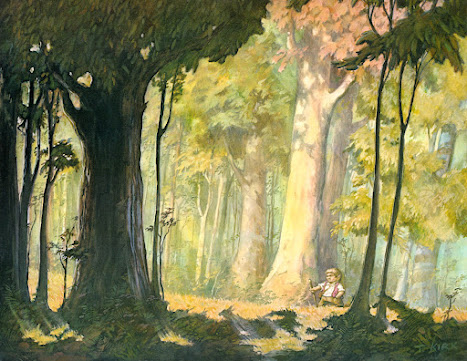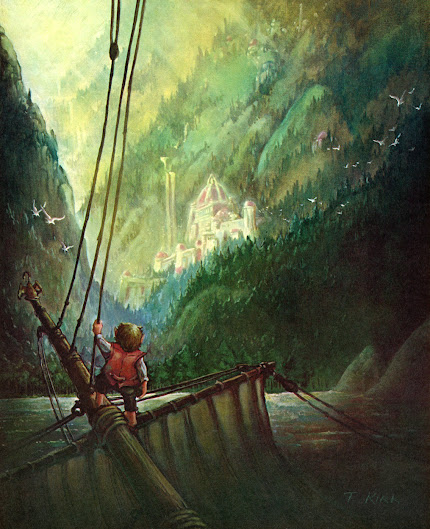In my first Lord of the Rings article on Black Gate, a commenter described the book as "tasting of ashes" and attributed it to Prof. Tolkien's experiences during the First World War. I don't taste the ashes, but there are parts of the trilogy that reek heavily of them. He had managed to defer joining the army (as an officer) until he graduated in 1915. This meant he missed the early portion of the war - the Marne, Loos - but it meant he literally had his baptism of fire during the Somme Offensive.
Initiated to relieve the German pressure on the French at Verdun, the Somme Offensive lasted from July 1, 1916, thru November 18, 1916. Tolkien was there until nearly the end, only being invalided out in October after contracting trench fever. The opening day of the battle is the deadliest day in British history. There were 60,000 casualties with 20,000 killed. The final casualties of the offensive between the British, French, and German armies were over one million.
Tolkien's children said, "he would occasionally talk of being at the front: of the horrors of the first German gas attack, of the utter exhaustion and ominous quiet after a bombardment, of the whining scream of the shells, and the endless marching, always on foot, through a devastated landscape, sometimes carrying the men's equipment as well as his own to encourage them to keep going." Of his close friends, only one survived the war. The United Kingdom, with a population of about 42,000,000 when the war started, lost almost 900,000 dead. That all this might permeate The Lord of the Rings isn't surprising.
 |
| Crossing the Dead Marshes by Ted Nasmith |
Presently it grew altogether dark: the air itself seemed black and heavy to breathe. When lights appeared Sam rubbed his eyes: he thought his head was going queer. He first saw one with the corner of his left eye, a wisp of pale sheen that faded away; but others appeared soon after: some like dimly shining smoke, some like misty flames flickering slowly above unseen candles; here and there they twisted like ghostly sheets unfurled by hidden hands. But neither of his companions spoke a word.
At last Sam could bear it no longer. ‘What’s all this, Gollum?’ he said in a whisper. ‘These lights? They’re all round us now. Are we trapped? Who are they?’
Gollum looked up. A dark water was before him, and he was crawling on the ground, this way and that, doubtful of the way. ‘Yes, they are all round us,’ he whispered. ‘The tricksy lights. Candles of corpses, yes, yes. Don’t you heed them! Don’t look! Don’t follow them! Where’s the master?’
Sam looked back and found that Frodo had lagged again. He could not see him. He went some paces back into the darkness, not daring to move far, or to call in more than a hoarse whisper. Suddenly he stumbled against Frodo, who was standing lost in thought, looking at the pale lights. His hands hung stiff at his sides; water and slime were dripping from them.
‘Come, Mr. Frodo!’ said Sam. ‘Don’t look at them! Gollum says we mustn’t. Let’s keep up with him and get out of this cursed place as quick as we can – if we can!’
‘All right,’ said Frodo, as if returning out of a dream. ‘I’m coming. Go on!’
Hurrying forward again, Sam tripped, catching his foot in some old root or tussock. He fell and came heavily on his hands, which sank deep into sticky ooze, so that his face was brought close to the surface of the dark mere. There was a faint hiss, a noisome smell went up, the lights flickered and danced and swirled. For a moment the water below him looked like some window, glazed with grimy glass, through which he was peering. Wrenching his hands out of the bog, he sprang back with a cry. ‘There are dead things, dead faces in the water,’ he said with horror. ‘Dead faces!’
Gollum laughed. ‘The Dead Marshes, yes, yes: that is their name,’ he cackled. ‘You should not look in when the candles are lit.’
‘Who are they? What are they?’ asked Sam shuddering, turning to Frodo, who was now behind him.
‘I don’t know,’ said Frodo in a dreamlike voice. ‘But I have seen them too. In the pools when the candles were lit. They lie in all the pools, pale faces, deep deep under the dark water. I saw them: grim faces and evil, and noble faces and sad. Many faces proud and fair, and weeds in their silver hair. But all foul, all rotting, all dead. A fell light is in them.’ Frodo hid his eyes in his hands. ‘I know not who they are; but I thought I saw there Men and Elves, and Orcs beside them.’
‘Yes, yes,’ said Gollum. ‘All dead, all rotten. Elves and Men and Orcs. The Dead Marshes. There was a great battle long ago, yes, so they told him when Sméagol was young, when I was young before the Precious came. It was a great battle. Tall Men with long swords, and terrible Elves, and Orcses shrieking. They fought on the plain for days and months at the Black Gates. But the Marshes have grown since then, swallowed up the graves; always creeping, creeping.’
 |
| The Dead Marshes by Alan Lee |
‘But that is an age and more ago,’ said Sam. ‘The Dead can’t be really there! Is it some devilry hatched in the Dark Land?’
‘Who knows? Sméagol doesn’t know,’ answered Gollum. ‘You cannot reach them, you cannot touch them. We tried once, yes, precious. I tried once; but you cannot reach them. Only shapes to see, perhaps, not to touch. No precious! All dead.’
Sam looked darkly at him and shuddered again, thinking that he guessed why Sméagol had tried to touch them. ‘Well, I don’t want to see them,’ he said. ‘Never again! Can’t we get on and get away?’
‘Yes, yes,’ said Gollum. ‘But slowly, very slowly. Very carefully! Or hobbits go down to join the Dead ones and light little candles. Follow Sméagol! Don’t look at lights!’
from The Passage of the Marshes



























